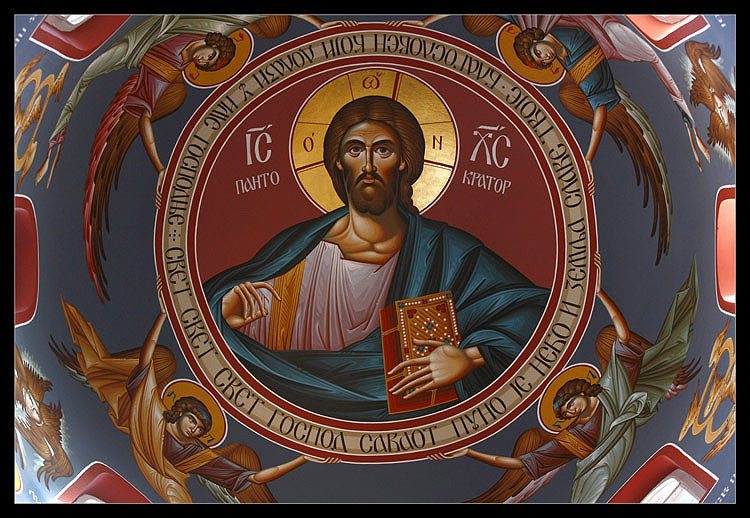I find these arguments very strange. The most commonly cited “proof” is from Ex 20:4 and similar passages: “Thou shalt not make unto thee any graven image, or any likeness of any thing that is in heaven above, or that is in the earth beneath, or that is in the water under the earth” (KJV).
This is certainly true, especially when considering that the Israelites fashioned for themselves a golden calf and, in various ages, many other idols of Cannanite, Babylonian, and Assyrian gods. In these times God was without image. From Genesis and throughout the Old Testament God is not described as having proportions or form but rather as expansive, immense, and beyond comparison. Images, or more specifically similes and metaphors, were used to describe the power, love, and greatness of God, but no images were fashioned.
Moreover John the Apostle attests that “no one has ever seen God” (1 John 4:12 RSV). So why, then, do Catholics portray Christ as well as God the Father and God the Spirit?
There are logical proofs for such actions and dispositions, but they are logical proofs grounded in Scripture and the reality they portray.
It begins with the reality of Christ himself: that he is the Word and that he is God. This Word is the “image of the invisible God” (Col 1:15) and he “reflects the glory of God and bears the very stamp of his nature” (Heb 1:3). Similarly this all-powerful and glorious Word “became flesh and dwelt among us” (Jn 1:14). Thus God who was in former times had revealed himself in shadows and imperfect things, such as the prophets and the Law, now revealed himself in his perfect Son. The source of light is not seen in darkness, and we are all blind. But Jesus Christ, who gives sight to the blind, is “the light of the world” (Jn 8:12). We not only beheld him with our eyes but, as John said, we have also “looked upon [him] and touched [him] with our hands” (1 John 1:1).
 |
| Such art gives an example of an actual Biblical text and, more importantly, the New Testament relates the actual life of Jesus, even if Scripture can not simply be reduced to a historical text. |
Jesus was truly God and truly man, something to which Scripture and faith attest. Jesus is in the Father and the Father is in Jesus (cf., Jn 17:21). All who believe in Jesus Christ have come to believe because they have heard about him from those who believe and who were sent out just as Jesus had been (cf. Jn 17:18). Similarly, the power of Jesus is described, just as the power of God had been described as of old, but now the power of God is expressed in image and flesh. This is how John the Baptist could say “Behold, the Lamb of God!” (Jn 1:29) and how Stephen could say “Behold, I see the heavens opened and the Son of Man standing at the right hand of God” (Acts 7:56).
Catholics depict Christ because he was seen both in his earthly flesh as well as his heavenly glory, both in Christ crucified and in Christ risen. Paul proclaims and preaches “Christ crucified” (1 Cor 1:23) and John looked upon the power and image of Christ the King in the book of Revelations. Thus not only was God seen but he was described. While, for example, his resplendence in heaven is described in metaphor and prophetic language the person of Christ is described as being who he is: a man who was humbled and humiliated on earth but now rules both heaven and earth in the fullness of power.
Thus, because we proclaim Christ and his life which was real, which was seen and touched, and which revealed the fullness of God and his plans. The Father has truly “made known to us in all wisdom and insight the mystery of his will” (Eph 1:9) through Christ Jesus, and the light Jesus provides is his life as model, truth, and guide.
As such, when Catholics express Christ in stained-glass, in a crucifix, and in various media, it is because we are expressing the truth that Christ, in his very reality and image, reveals God to us. It was once blasphemous to portray God with graven images since no one had ever seen God and God had not yet revealed himself to the nations. Similarly it was contrary to the law to eat certain foods until Christ had made them clean. Yet in these last days God has revealed himself by his only-begotten Son and his Son showed us the way we should go in power and in truth.
The images we fashion of Christ, of the Spirit (as dove and fire), and the Father (similar to the Son) are expressions of the reality of Christ. In the eastern traditions of Catholicism and in among some of our Orthodox brethren only Christ is portrayed as a theological point that the Spirit and Father are both never seen or described, but that the image of Christ is also the image of the other two. I think the iconography of the east also has powerful and rich meanings behind it. Catholics too express the reality of God revealed through their art. Calling it blasphemous and idolatry is not only ignorant but foolish in light of the Gospel.
 |
| Christ the All-powerful (Pantokrator) |
